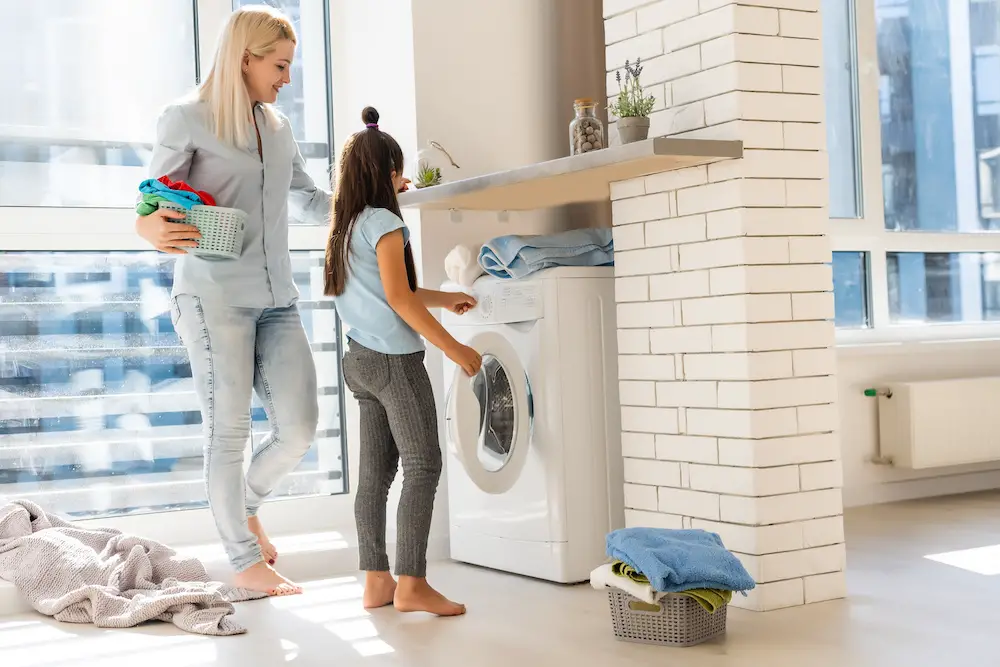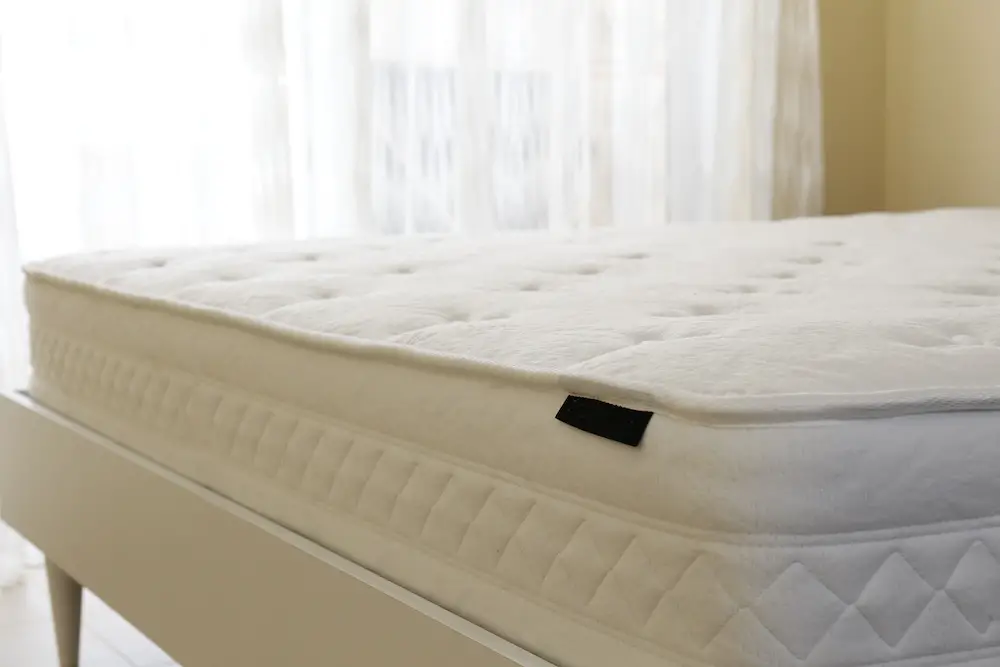As the first line of defense, your mattress protector is responsible for keeping your mattress in tip-top shape.
Learning how often to wash mattress protectors can upgrade your bedroom with a few simple steps.
Interestingly, there are different care instructions depending on what you need and expect from your bed.
How Do Mattress Protectors Work?
As their name suggests, mattress protectors do just that—they protect your mattress.
Traditionally, they are slipped or zipped over the entirety (or top) of your mattress to add an extra layer of protection.
Some use mattress protectors to ward off spills and stains; others use them as a line of defense against allergens.
Instead of having to wash your mattress regularly, you simply remove the mattress protector and clean it.
To add to their convenience, you can machine-wash and tumble-dry most mattress protectors.
If you have a more delicate mattress protector, you might have to hand wash it, which is still easier than washing a whole mattress.
After cleaning your mattress protector, you simply put it back on your bed.
Then, finish making the bed with fresh linens to rejuvenate your sleeping experience.
They are a phenomenal addition to any bedroom, and every sleeper should consider investing in one.
How Often to Wash Mattress Protector: Top Care Instructions
There’s no doubt that a mattress protector can be the perfect thing to add to your linen collection.
Like your sheets, you should clean and care for your mattress protector as well.
Let’s take a look at some of the primary care instructions for everyday occurrences.
For Regular Sleep
Our beds are the most used furniture in our homes and are subjected to plenty of buildup.
Even if you shower before bed, dead skin, body oils, and mites can easily find homes within your linens.
It’s important to clean your mattress protector as much as possible to keep your linens clean.
With that said, you don’t need to clean it every one to two weeks, the same as you would your linens.
Instead, washing it every one to two months should help to keep it in tip-top shape.
For Food and Drink Spills
Of course, there are certain instances where you might need to spot-treat or clean the protector earlier than expected.
Eating and drinking outside of your bedroom is always the best option to prevent permanent damage to your linens.
However, in rare instances, it can be nice to enjoy a quick snack or a glass of wine in the comfort of your bedroom.
If you happen to spill food or drink while in bed, it’s best to wash the mattress protector immediately.
Without cleaning the spill right away, the food and drink can seep into the mattress protector or topper.
Although it likely won’t stain your mattress, it will surely stain the protector and your linens.
You’ll have the best chance if you blot the spill away and then either spot-treat or machine-wash the entire sheet to prevent staining and smells.
For Allergies
Allergies can be frustrating to live with, especially if you tend to wake up congested first thing in the morning.
Apart from small particles in the air, did you know that your mattress protector can also trap allergens?
As dust and pollen circulate through the air, they get caught in the plush fabrics of your mattress protector.
Over time, these allergens build up and will be inhaled every time you lay your head down for rest.
Someone with allergies should consider cleaning their mattress protector bi-monthly, if not monthly.
The best way to determine how often to clean is based on how often you wake up congested.
If you find that you still feel stuffed up on a bi-monthly schedule, try switching to more regular cleans.
However, it’s important to note that the more often you clean your mattress protector, the more it will wear down.
A better alternative is to find a hypoallergenic protector that can help alleviate any sinus issues.

For Guest Bedrooms
Likely, your guest bedrooms aren’t used as often as your main bed.
With that said, you can save plenty of time by only washing your mattress protectors every three to four months.
Like with allergies, even unused guest bedrooms can attract dust into the mattress protectors.
A great practice is cleaning the protector before and after guests come to stay at your home.
Doing this helps make sure your guests have a clean place to sleep in and that it’s properly sanitized after they leave.
For Illnesses
When you’ve come down with the flu or cold, your bedding is at the forefront of your illness.
Every time you sneeze or cough, particles can travel into the fabric of your linens and embed themselves deep in the material.
Just like you would wash your linens after you’ve started to get better, your mattress protector should be cleaned too.
Doing so helps remove any extra bacteria that could be trapped in the fabric’s crevices.
Also, it will give you an incredible feeling to know your bedding is spotless.
Tips for Washing a Mattress Protector
Now that you have a good idea of how often you should wash your mattress protector, let’s get into the process.
Fortunately, it’s just as easy as keeping your linens clean, though you should look at the specific care instructions for your model.
You can wash some mattress protectors in the washing machine, but others require dry cleaning or hand washing.
Step 1: Spot Treat
The first thing you’re going to want to do before thoroughly washing your mattress protector is to spot-treat any problem areas.
You might have specific spots where sweat stained the fabric or if you’ve recently spilled a drink at night.
Spot treating helps eliminate the deepest embedded dirt before doing an all-over clean.
Doing it on mattress protectors is simple, as all you need is one part baking soda and one part water.
Alternatively, you can find bed-safe store-bought products designed to lift stains out of plush materials.
Gently blot the stain out of the fabric as much as possible before moving onto the next step.
Step 2: Look at the Care Instructions
Before you put it in the wash, you’ll want to make sure its materials can withstand washing.
Otherwise, you will have to hand-wash the entire protector, which can be a little more time-consuming.
To hand-wash your mattress protector, you’ll want a small bucket filled with warm water and a mild detergent.
You’ll also need to use a soft, clean cloth to scrub away hidden traces of dirt and grime.
Start by working at the bottom of the mattress protector, ensuring you clean every inch thoroughly.
Afterward, gently rinse the mattress protector with cold water and hang it out to dry.
More often than not, if you can wash it in the machine, you can also put it in the dryer.
Step 3: Machine Washing
If you’re lucky enough to throw your mattress protector in the washing machine, cleaning is even easier.
When doing so, you will want to make sure you use cold water to prevent it from shrinking as well as a mild detergent.
It is best to avoid using bleach, as it can wear down the materials over time.
Another recommendation is to put it through a second rinse cycle to ensure there is no detergent left.
If you leave any behind, it can cause mildew to build up in the fill.
Step 4: Drying
When drying a mattress protector, it is very important to ensure it doesn’t shrink.
The best recommendation is to let it air dry, though tumble drying on low heat can speed up the job.
Once it is completely dry, you can put it back on your bed with your favorite sheets.
Final Thoughts
Knowing how often to wash mattress protectors is simple with the help of some elementary care instructions.
By immediately treating spills and staying on top of a regular cleaning routine, you can be sure that your bed always looks its best.
Even better, doing this will help prolong your mattress’ lifespan.

